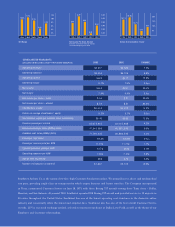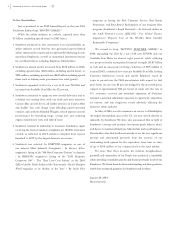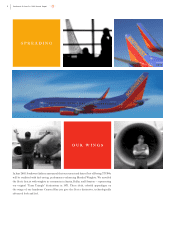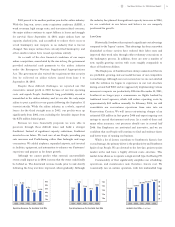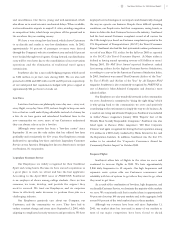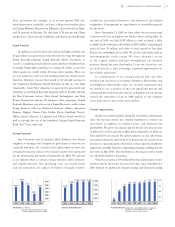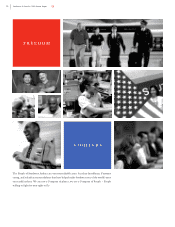Southwest Airlines 2003 Annual Report Download - page 6
Download and view the complete annual report
Please find page 6 of the 2003 Southwest Airlines annual report below. You can navigate through the pages in the report by either clicking on the pages listed below, or by using the keyword search tool below to find specific information within the annual report.
5
Southwest Airlines Co. 2003 Annual Report
2003 proved to be another perilous year for the airline industry.
With the Iraq war, severe acute respiratory syndrome (SARS), a
weak economy, high energy costs, and terrorism-related concerns,
the major airlines continue to report billions in losses and struggle
for survival. Since September 11, 2001, major airlines have cut
capacity, slashed jobs, and scrambled to reduce their costs to
avoid bankruptcy and compete in an industry that is forever
changed. Two major airlines have already filed bankruptcy, and
other smaller carriers have ceased operations entirely.
As a result of the dire financial condition of our major
airline competitors, exacerbated by the war in Iraq, the government
provided substantial cash payments to the airline industry
under the Emergency Wartime Supplemental Appropriations
Act. The government also waived the requirement that security
fees be collected on airline tickets issued from June 1 to
September 30, 2003.
Despite these difficult challenges, we reported our 31st
consecutive annual profit in 2003 because of our low operating
costs and superb People. Southwest’s long profitability record is
unmatched in the airline industry, and we are also the only major
airline to post a profit in every quarter following the September 11
terrorist attacks. While the airline industry, as a whole, reported
losses for the third straight year in 2003, our profits were up
significantly from 2002, even excluding the favorable impact from
the $271 million federal grant.
Because we were financially prepared, we were able to
persevere through these difficult times and build a stronger
Southwest. Instead of significant capacity reductions, Southwest
invested in our future. We took care of our People, providing pay
rate increases and Profitsharing rather than furloughs and wage
concessions. We added airplanes, expanded airports, and invested
in facilities, equipment, and automation to enhance our Customers’
experience and prepare us for future growth.
Although we cannot predict what external, uncontrollable
events could impact us in 2004, it seems that the worst could finally
be behind us. The downward revenue trends prior to and shortly
following the Iraq war have improved, albeit gradually. Although
the industry has planned for significant capacity increases in 2004,
we are confident in our future and believe we are uniquely
positioned for growth.
Low Costs
Historically, Southwest has enjoyed a significant cost advantage
compared to the “legacy” carriers. That advantage has been somewhat
diminished as those carriers have reduced their labor costs and
improved their work rules through either voluntary concessions or
the bankruptcy process. In addition, there are now a number of
new, rapidly growing carriers with costs roughly comparable to
those of Southwest Airlines.
The Employees of Southwest have always understood that we
are profitable, growing, and successful because of our competitive
cost advantage. Although our costs remain low, we are not satisfied
with the inflation we began to experience in our cost structure
during second half 2003 and are aggressively implementing various
measures to improve our productivity. Effective December 15, 2003,
Southwest no longer pays a commission on flights booked by
traditional travel agencies, which will reduce operating costs by
approximately $40 million annually. In February 2004, we will
consolidate our reservations operations from nine into six
Reservations Centers. We will incur restructuring charges of an
estimated $20 million in first quarter 2004 and expect ongoing cost
savings to exceed that amount each year. As a result of these and
many other measures, cost pressures should ease in second half
2004. Our Employees are motivated and innovative, and we are
confident that our People will continue to find and embrace faster
and better ways of running our business.
While a lot of factors contribute to Southwest’s historic low
cost advantage, the primary driver is the productivity and Southwest
Spirit of our People. We are devoted to the low-fare, point-to-point
market niche and have a highly efficient route structure. This
market focus allows us to operate a single aircraft type, the Boeing 737.
Commonality of fleet significantly simplifies our scheduling,
operations, and maintenance and, therefore, lowers cost. We
consistently run an ontime operation, with few mishandled bags
8.96¢
9.43¢
8.51¢
9.5¢
9.0¢
8.5¢
8.0¢
7.5¢
7.0¢
1999 2000 2001 2002
Operating Revenues Per Available Seat Mile
8.02¢
2003
8.27¢
1999 2000 2001 2002
Operating Expenses Per Available Seat Mile
7.48¢
7.73¢
7.54¢
7.41¢
2003
7.60¢
7.8¢
7.6¢
7.4¢
7.2¢
7.0¢
70
60
50
40
30
1999 2000 2001 2002
52,855
59,910
65,295 68,887
2003
71,790
Available Seat Miles (in millions)

